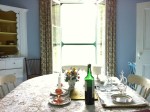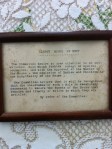Month: August 2012
The Clergy House of Rest
The Clergy House of Rest
My second day at the parsonage attached to the summer parish of Cacouna QC, my friend Eric, who had come down to spend a couple of days with me in Bas St-Laurent, found a small plaque on the mantel of the fireplace. It’s a short text, written in old and uneven typewriter script, and deserves quoting in full. The capitals (interesting in and of themselves) are there in the original:
The Committee desire to draw attention to an established Rule which forbids except on special occasions, and with the approval of the Master of the House – the admission of Ladies and Children to the hospitality of the House.
The Committee believe that it will be recognised that the observance of such a Rule is absolutely necessary to secure the Guests of the House that freedom and liberty of action to which they are entitled.
By order of the Committee
There’s no date, and no easy way to situate the notice, but it seems to be a bit of historical luggage left over from the 1920s or 30s. Whichever modern parishioner of the parsonage found this and dug it out must have had a sense of humour. She’s probably also the one who found a photograph that seems to go with it. The photo shows a group of middle-aged men, all in suits, sitting or standing on the veranda of a house very much like the present day parsonage of St James Cacouna. Some are wearing clerical collars. They are looking at the camera, and a few out toward the St-Lawrence (it’s hard to know whether to call it the St-Lawrence or “the sea” here since it’s a bit of both. It’s a river, but some 20 miles across, with six to eight foot tides and salt water). Some of the men are smiling, but most, as was the fashion of the day in front of cameras, look grim. Presumably, the looks on their faces indicate that they are enjoying “that freedom and liberty of action to which they are entitled”!
It would be easy to moralize over such a plaque. But times have changed, and little is accomplished by such straw-man opinions. Likely the men who were responsible for this directive wanted, more than a release from women and children, a release from themselves and their domestic lives (we still go on “retreats”, and these still involve getting away from responsibilities as far as one is able). The capitalization of the word “Rule” is interesting, however – is it possible, I wonder, that whoever framed this had in mind, consciously or unconsciously, the far more official and effective monastic “Rules” such as the Rule of St-Benedict? If so, perhaps there were some frustrated monastics amongst that surly lot on the steps.
But the phrase that most piques my interest is the last line: “that freedom and liberty of action to which they (that is, the clergy) are entitled.” Leaving aside for a second the word “entitled”, it begs the question: what exactly did they DO in the clergy house of rest? Smoke cigars? Surely, in the 1920s, the men did that at home. Tell dirty jokes? Golf? Fish? Walk around in their slippers all day and read the paper? None of these seem exclusively the province of a “house of rest.”
Maybe the “freedom and liberty of action” meant, for these men, temporarily laying aside the heavy weight of being clergy in a culture and time less libertarian than our own, where clergy had a much higher profile and were under much greater scrutiny. Let’s face it, most people barely know we exist these days, and find us more a curiosity than an object of judgment. But in the 1920s, in a stratified Anglo society, things were different. Maybe this Rule expresses the desire of these men to be free to express unorthodox opinions on certain church issues (to tell sacrilegious jokes rather than dirty ones), to be able to vent about people in their parishes, or to be able to pretend, for a time, that they were not “marked” by their ordination vows to be forever different from the rest of society.
It’s also possible that in these words we find the same somewhat unformed but strong urges for male unity and self-awareness that mark the “masculinity movement” of recent decades. And of course, it’s hard for us moderns not to look at that photograph, read these words, and wonder if there were not, again perhaps unconsciously, some homoerotic urges on the part of at least some of those men, the forbidden feelings for which “mens’ clubs” were once a cover.
That’s probably going too far. Maybe, the framers of this “Rule” didn’t really know themselves what they wanted, and “freedom” and “liberty” were words that expressed a yearning more than any actual plan of action. If so, I hope that they found what they yearned for, without having to resort too often to such petty, clumsy and dictatorial decrees as this “Committee” seemed prone to making.
It’s the end of my week in Cacouna. Eric left on Wednesday and when Cathy decided not to come up with her mother as planned, it occurred to me that as a man alone in the house, I was living by the Rule of the Clergy House of Rest! The Parish of St James has been tremendously welcoming to me, and the House (there, I’m picking up the capitalization habit) has been a God-send. Some days the fog rolled over and through the grand old place, making it eerily moody, and other days, when the sun was shining over the gulf, I’ve sat at my computer and watched, hoping to see the Beluga whales that sometimes pass by out in the sparkling waters. I can hear the foghorns of the freighters on the one side, and the lonely sound of the Gaspe train on the other. Up on highway 132, cars with campers pass by, and tourists stop to look at the signs describing the historic village of Cacouna. We haven’t stopped needing places of rest. But I’m glad that the parish of St James Cacouna is now so much more welcoming than was, once, the “Clergy House of Rest”.


